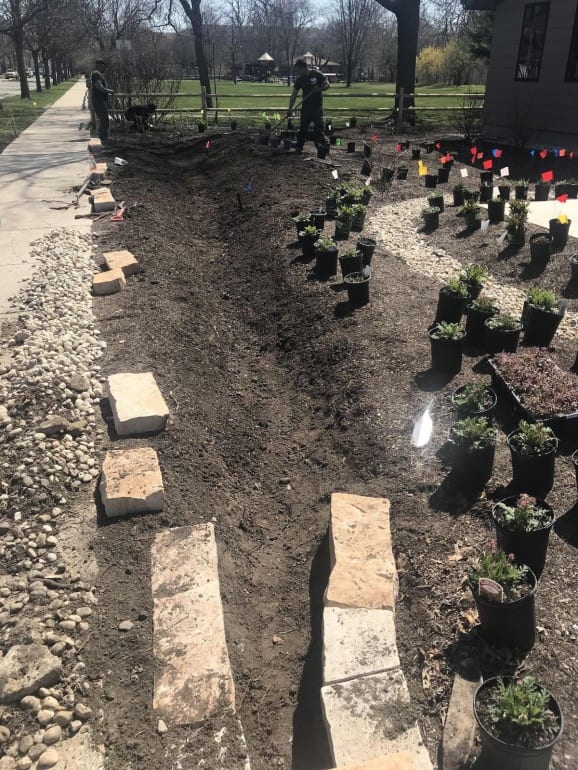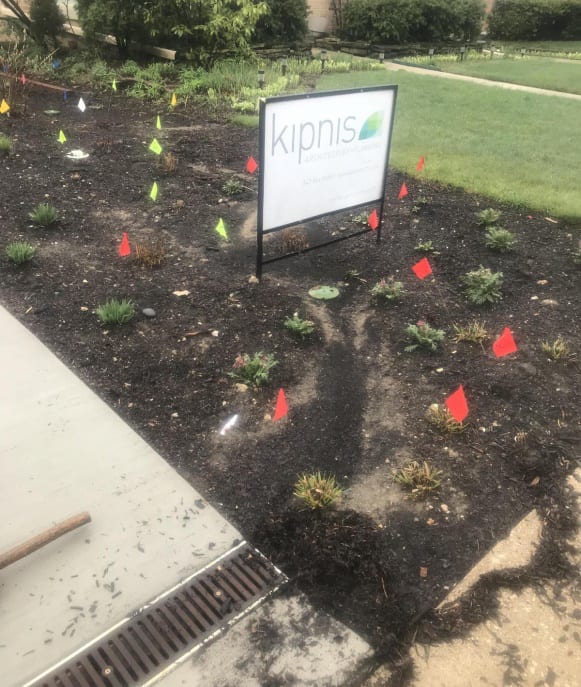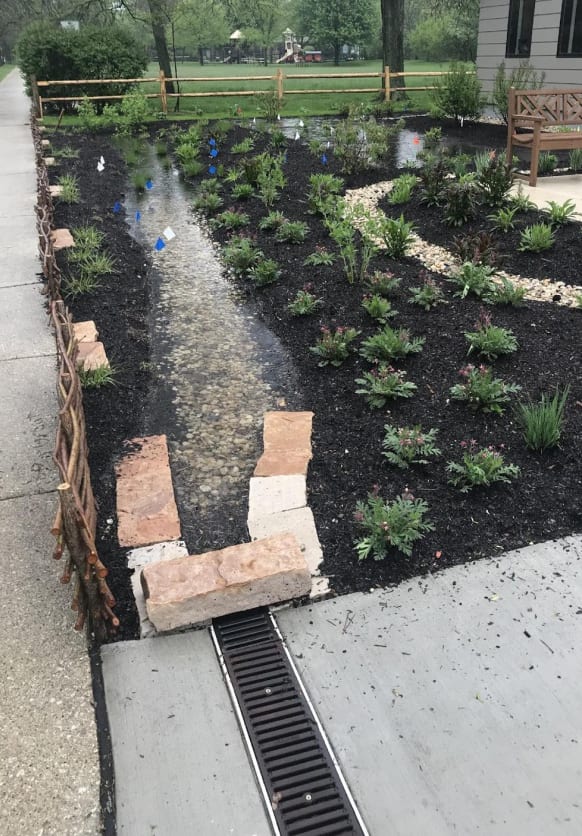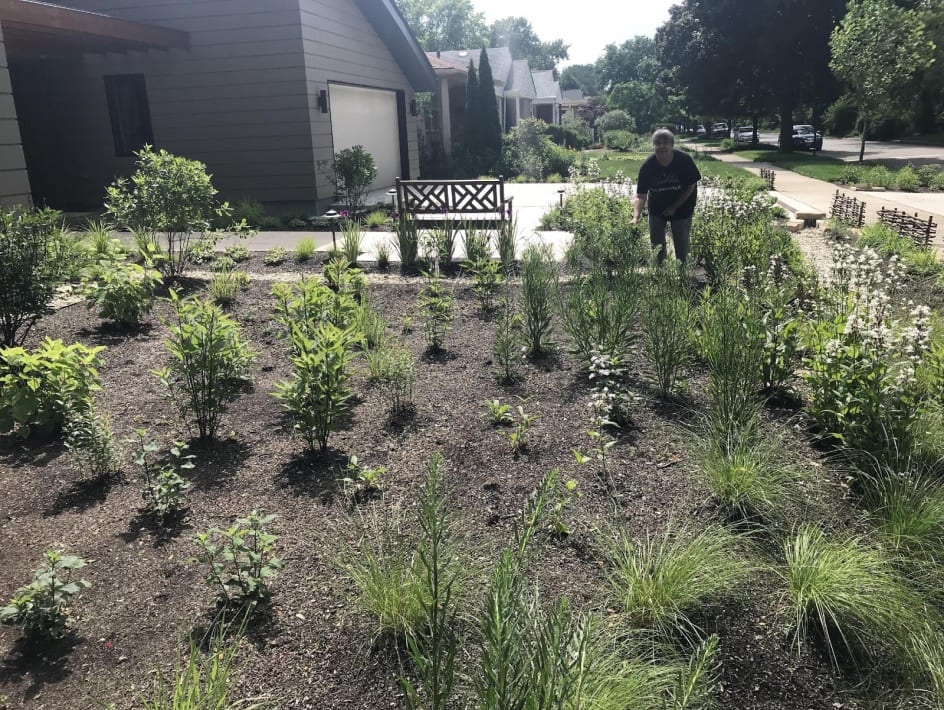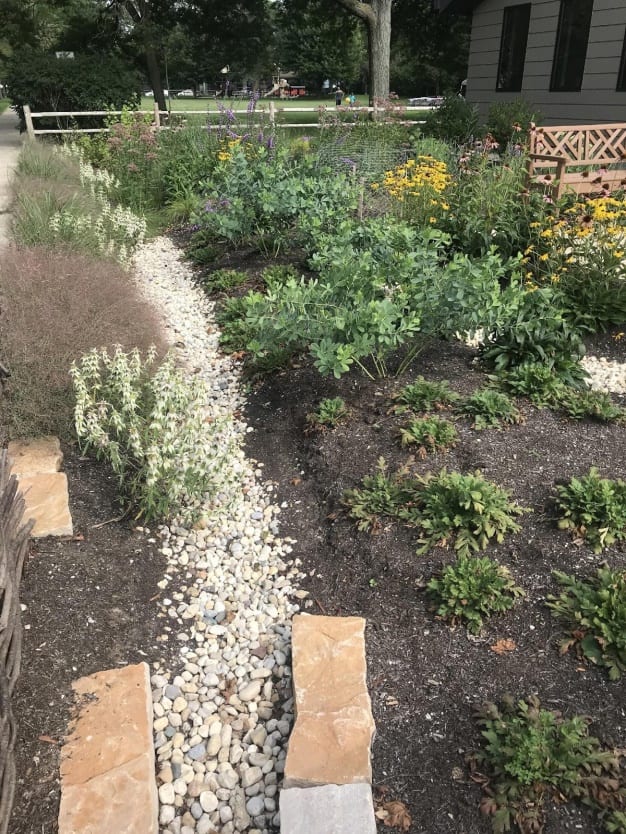by Julia Bunn
The summer of 2018 here in the Midwest (Chicago area), regional weather conditions had a huge effect on installation of a landscape on the property of one client. I’ve anchored my story in the unfolding of project events in relationship to the rain. After all, the main purpose of the entire landscape was in-place management of all the rainwater that fell on the property and creation of a landscape that was eco-functional though not purely planted with regionally local plants. We used native cultivars occasionally because we knew those choices would help the client manage the garden in the future; however, we included as many straight native species as was suitable to the client’s requests. I address some of those choices in this article.
Preface
In fall of 2016, I was invited by LEED architect Nate Kipnis to be a member of the team seeking LEED Platinum certification for the new home being built for of one of his clients. My specific interest as a designer is creating landscapes for rainwater management while also seeking out plant materials that are amenable to the residential client. It became immediately apparent that the possibility of managing all the rain water runoff from my client’s new home on the property was a very attractive idea! At first she considered adding a cistern, but the long term management of such a structure did not appeal to her, as she was also designing the home to be able to “age in place.”
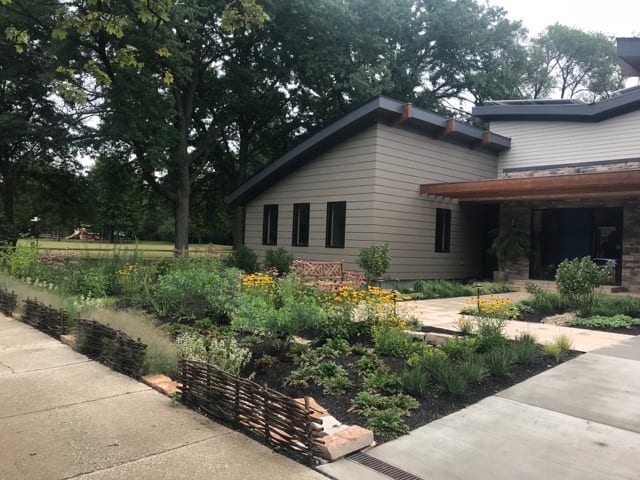
Neighbors and passersby often stop to comment on how much they appreciate the beauty of the completed gardens. We always mention the functionality.
In her wish list, the client expressed the desire for a “bee friendly garden” – a garden that her small dogs could enjoy and would offer multiple seasons of bloom for the pollinators. Blue-eyed grass and woodland phlox rapidly became two of her favorite plants because blue and purple were her favorite colors. We chose the Lucerne cultivar Sisyrinchium angustifolium because it reportedly reseeds less freely than the native, making care of the client’s garden easier to manage. Bees still harvested well from the cultivar, while the plants provided a “civilized” border planting for the property’s front entrance. These ideas, along with many others, all added to the client’s delight with her new garden.
Process
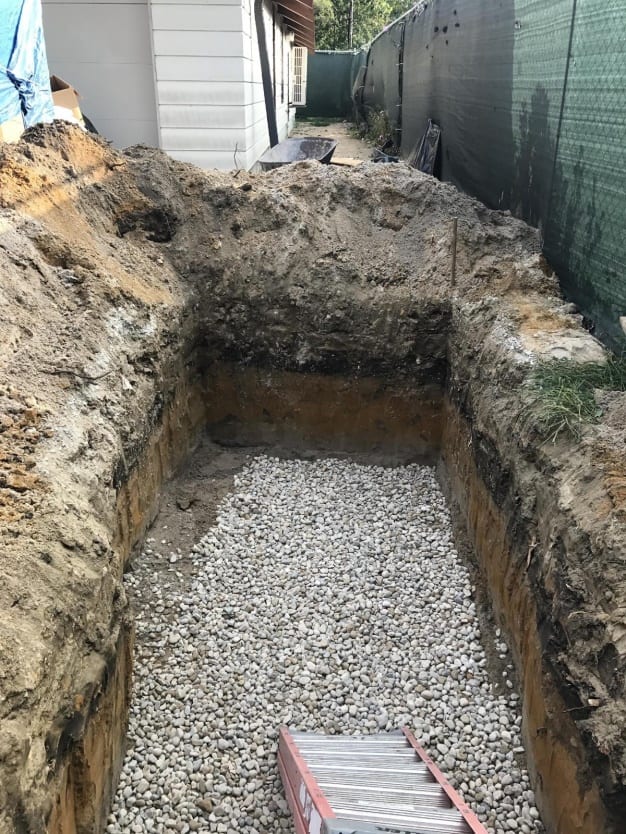
Excavation for the green infrastructure piece that drew the attention of city engineers. Put in place before grading began, its location was in an area that needed to take in over 1115 Gallons of water in a two-inch rain event from a downspout that is conveying roof runoff from an 808 sf area. A minimum of 404 sf would be needed to construct a rain garden, and we only had 120 sf of garden space available.
Now turning to the process, we ran into a problem early. The initial construction elevations were not based on the design we proposed, so when we began completing our grading in the fall of 2017, a City of Evanston engineer, who was unfamiliar with the Cultec infiltration system we were using in order to complete our goal of keeping all our water on-site, requested a stop work order. The city had not, prior to our installation, encountered using such a solution for a residential landscape and wanted a drawn plan of our intended changes for the grading that explained how the water would be managed in lieu of the original plan that simply used grading to send stormwater away from the house and toward the street storm water system.
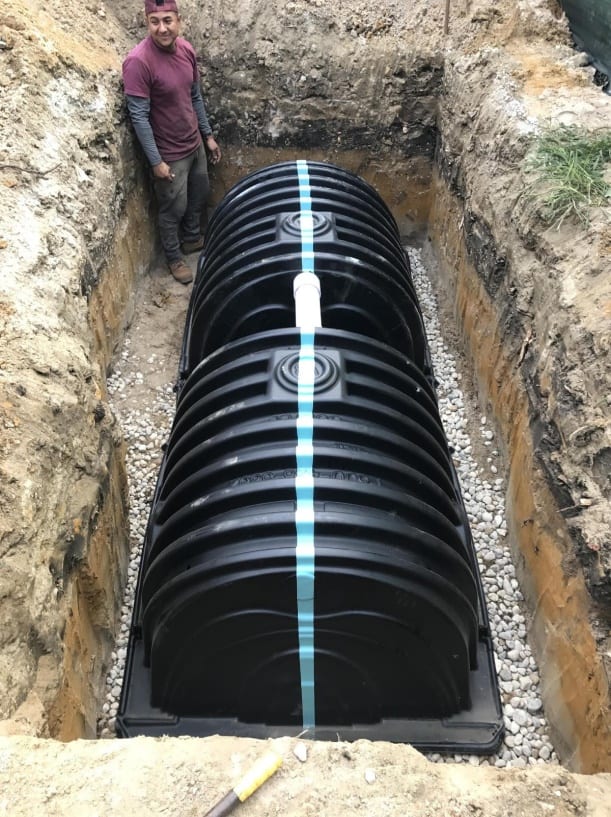
The two installed Cultec XLR330 rechargers manage, in a very small space, all of the water coming in from the roof.
The process of reworking the revised grading went smoothly because our supervising engineer from the city was immediately on board with our rainwater management plan and said she wished more people would utilize rainwater managing techniques like rain gardens, swales, and rechargers in their projects. The soil horizon in the Cultec excavation clearly supported that the site soil conditions of a sandy gravel were ideal for infiltrating large quantities of water and indicated that the local water table was also well below where our client was building. The new grading drawing and support documentation were completed and accepted by the city before winter freeze hit, which made it possible to complete the majority of the grading work, plant most of the shrubs, and partially install the drip irrigation system. The planting of the perennial rain gardens would have to wait until spring 2018.
Unfortunately, we were unable to complete the swale that was to handle the driveway runoff and the Parkway grading. With most of the grade set, we mulched the entire property with three inches of leaf mulch, which started our soil building for the next spring and kept us from having a muddy mess. And that is where we began the garden’s winter sojourn. Judging from the previous spring, we expected to get plants in the ground by mid-April of 2018, but Mother Nature had other plans.

The incomplete swale coming off the channel drain of 510 sf of concrete driveway at the front of the property needed to be finished to manage the water as planned.
February 2, 2018
The new landscape experienced its first winter thaw and freeze cycle, and all water was managed in the way we expected. However, it was immediately apparent that we needed to finish the swale designed to manage the driveway water. It needed to be 256 sf at a nine-inch depth that also encouraged a conveyance slope into the end ponding area. Weather had cut short the completion of this detail, but it went to the top of the list for completing in the spring before we could plant.
April 2018
On record as the fourth coldest April since 1872, planting was delayed across the entire region. We experienced the record-tying daily lowest minimum temperature of 31 degrees on April 29th (tied with 1958 and 2008, according to the National Weather Service). The cold temperatures affected everyone in the region and kept delaying our planting and the emergence of nursery plants from their winter dormancy.
May 1, 2018
With construction fencing finally down and the front swale finished, we started the garden planting. By color flagging the plantings, we could easily keep track of the nuances of inter-planting that would ensure different bloom cycle times within all of the beds.
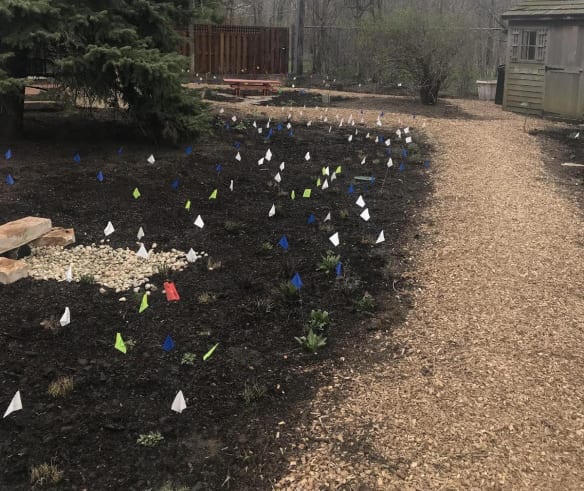
Using colored flags to mark plants, we monitored the beds for seasonal bloom. The bed shown here is in the back yard managing water off of the central roof that is conveyed via PVC pipe under the back patio to the garden.
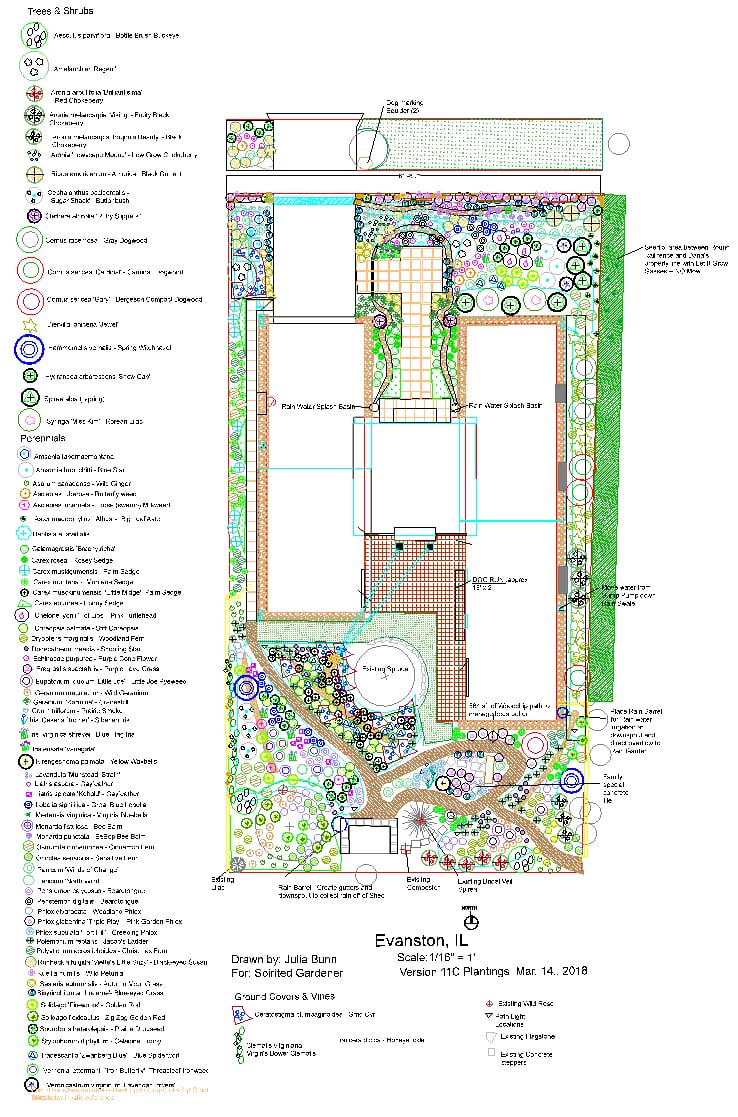
I work with AutoCAD Lite to create my planting plans because I feel I can use color to help with distribution of plants within the design. It helps the clients to envision things better, too.
The flagged bed shown above was initially planted with a cultivar of Carex muskingumensis ‘Little Midge’, which was a risky move because there was no known study of its ability to handle water the way its parent palm sedge did. My assumption that it would perform well based upon its lineage did not pan out. It basically failed. Later in the summer we changed to the native brome sedge (Carex bromides) as the design matrix sedge for this low field. It soon proved to be the resilient plant needed to do the job of managing the stormwater runoff from the house’s center roof while keeping a low profile bed, which is still a work in progress. The Little Midge palm sedge failure sent me back to the drawing board. We will add marsh marigold (Caltha paulustris) and more brome sedge next spring.

Here is the Low Sedge Rain Garden in July, before the coreopsis began to fail and after amending the plantings with the brome sedge to supplant the Little Midge palm sedge.
May 3, 2018
During the first rain event with the newly planted beds, we experienced a minor surprise grading mishap. Knowing we had planned well, we were surprised to discover an unexpected erosion trail three days after planting. The solution was a simple fix.
The neighbor’s downspout was pointing directly at our client’s yard. With the kind cooperation of the neighbor, we made a quick and easy fix – simply extending her downspout and directing the water into the grass in front of her garden bed. Additionally, we deepened the ponding area around the pop-up from the Cultec tanks, which was where the neighbor’s erosion path had gone before, just in case there was a return of the neighbor’s downspout problem or an overflow from the tanks. To date there has been no overflow, and we experienced two three-inch rain events between February 19 and February 20.
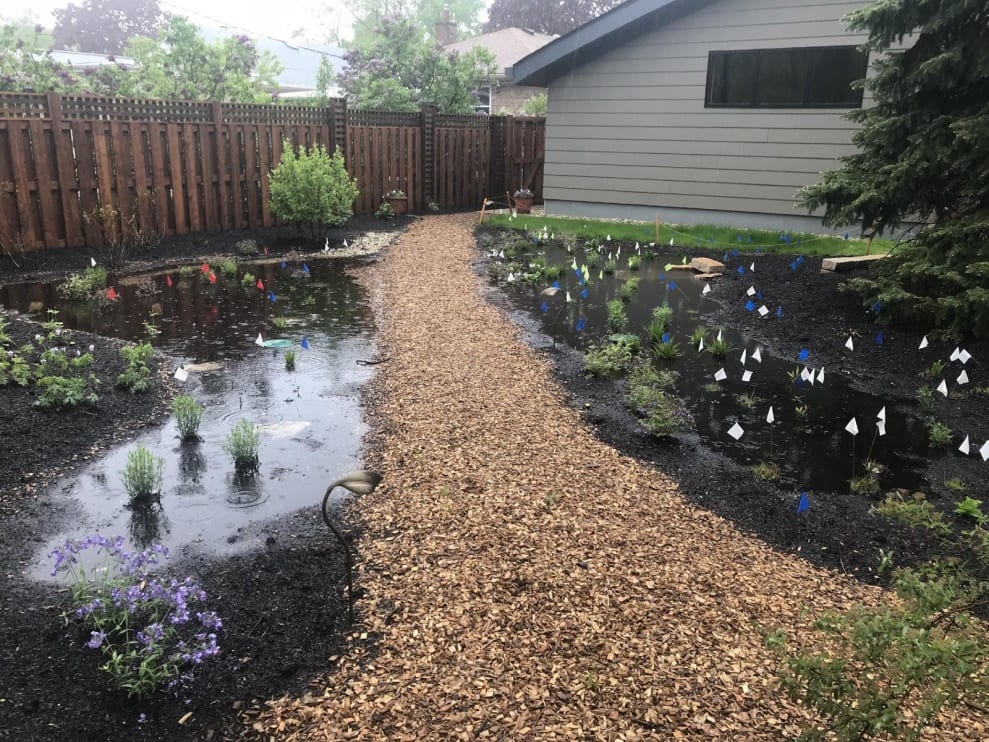
With most plants in place by May 2, the backyard rain gardens were put to work over several days of heavy rain in early May.
May 22, 2018
A two-inch rain event was registered with the National Rain Service on May 22nd. The front swale managed it handily!
The rain was followed by record high temperatures May 26-28, which affected many newly planted landscapes. Because we had a high efficiency irrigation system installed, a luxury, many homeowners cannot afford, plantings in their first year of establishment were protected. The system also got us points toward the home’s LEED Platinum qualification.
In our original design, we had wanted to put in a split rail fence to match the neighboring park’s fence, but city ordinances did not allow for that. Our solution was willow waddle sections that protected the gardens from dog walking erosion and provided a beautiful, sustainable protection barrier that met the “not more than 18 inches high criteria” set by the city.
June 2018
We again hit the record books when June 2018 ranked in the top 10 wettest Junes in the Chicago region. A total of 7.63 inches of rain was recorded, compared to the average of 3.45 inches (National Weather Report). It was at this time that I started to notice a super saturation of the back rain gardens. I checked in with the irrigation company and discovered two weeks into the month that the Rain Bird rain monitor had not been programmed into the system and needed adjusting. On top of a wet June, we had too much irrigation water. We put the irrigation cycles on reset to adjust to the atypical rain quantities before we realized what July held in store.
By the end of June, the first flush of baby rabbits came out to play and quickly hit the native phlox. The day after I introduced my client to the delights of her Saskatoon serviceberries (Amelanchier alnifolia), the rabbits devastated one of the shrubs. On high alert, we caged the others and saved what was still left of the remaining shrub. We applied cayenne and garlic spray to perennials. Where we re-applied after rains, it helped. Blue-eyed grass was the owner’s personal favorite bloom of the month.
July 2018
The entire month of July brought only 1.5 inch of rain in total. The rainfall occurred after over two weeks of no rain at all, creating drought-like conditions that affected many clients’ new plantings. Again we were grateful for the irrigation system. Many of the plantings did well despite the stressed conditions. The BeeBop bee balm (Monarda punctata) drew lots of attention from neighbors and prolific visits from pollinators.
August 2018
August brought more heavy rains with up to six inches of rain making its way to the gardens.
The parkway corner garden was not irrigated but hand watered when necessary. In this bed, prairie dropseed (Sporobolus heterolepsis), wild petunia (Ruellia humilis), purple cone flower (Echinacea pupurea) and black-eyed Susan (Rudbeckia fulgida ‘Viette’s Little Suzy) anchored the plantings, and bore testament to the resilience of natives and their cultivars.
Meanwhile, on the edge of the slope of the driveway swale, the purple love grass (Eragrostis spectabilis) charmed passerbys while the client enjoyed her great blue lobelia (Lobelia siphillitica.
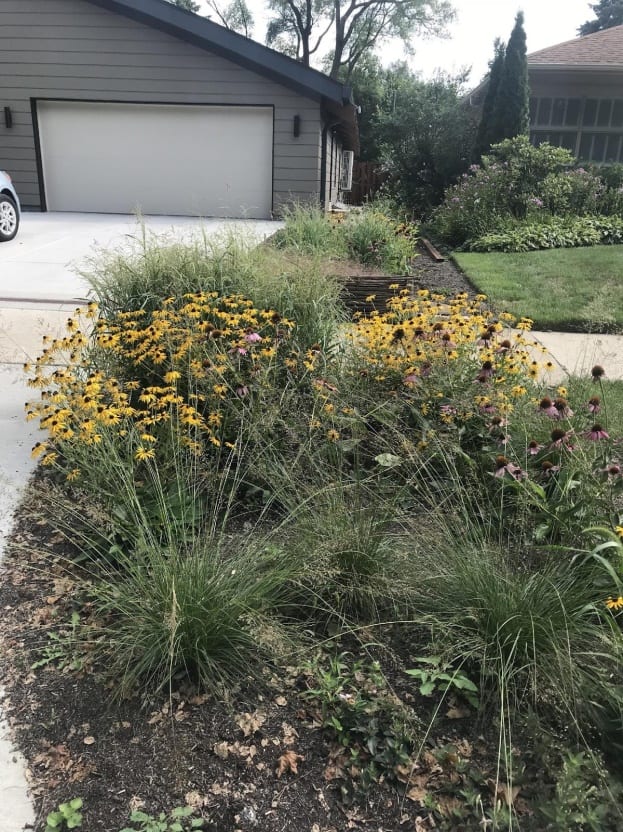
After drought conditions in July, the parkway garden looks great in August with minimal hand watering.
September 2018
Rainfall in September was fairly typical in the region at 3.65 inches. One exceptional statistic was the hottest September 20th on record at 93 degrees. We added some native plugs for more bloom in the front yard – with sky blue aster (Symphyotrichum oolentangiense) and brown-eyed Susans (Rudbeckia triloba). In the backyard beds we added little blue stem (Schizachrium scoparium) and rattlesnake master (Eryngium yuccifolium).
The one plant that truly disappointed was the prairie coreopsis (Coreopsis palmata). Listed as a Mesic prairie plant, I think the moisture level was just too high in the beds. They never bloomed and were also nibbled on by the rabbits along with the ironweed (Vernonia lettermani ‘Iron Butterfly’).
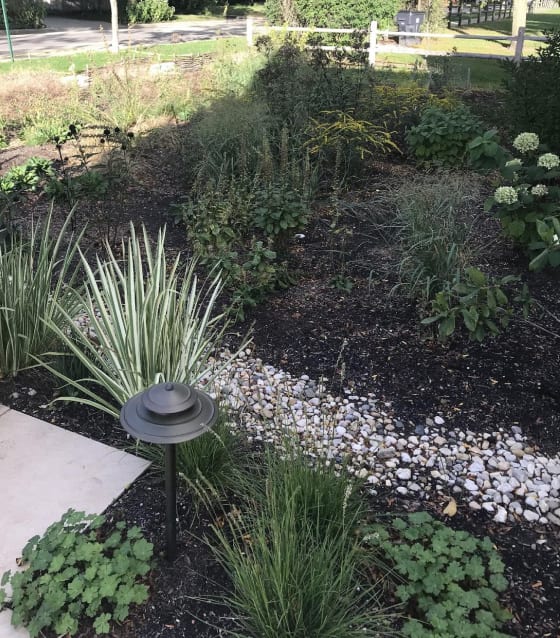
The front rain garden with goldenrod (Solidago rugosa ‘Fireworks’) shown in early October buzzed with pollinators still busily harvesting for the winter.
October 2018
October rainfall can be summarized as being a bit greater than the norm at 4.79 inches of rain for the month, which was 1.64 inches more than average. The heaviest rain in 24 hour occurred on October 1, registering 1.74 inches. All was well in the gardens with many plants going into winter dormancy. Our project achieved a happy ending to the story on October 30 when we received official notice that the property achieved LEED Platinum Residential status. A very pleased client sent an enthusiastic email: “And, I wouldn’t have platinum without you! We got 15 points from the landscaping and water management.”
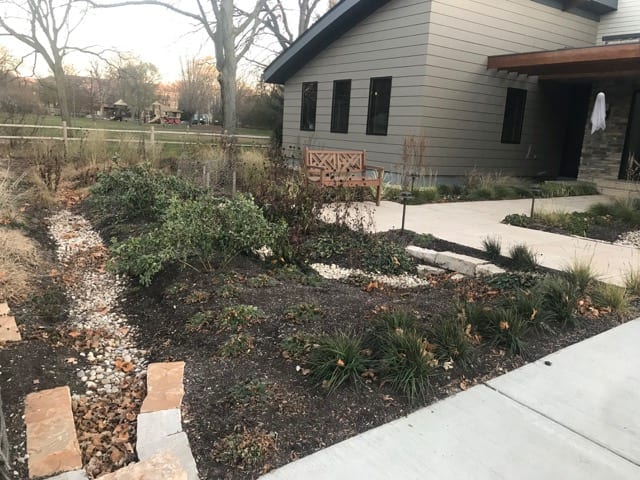
After six months of record breaking rainfall and temperatures, the garden edges toward its winter dormancy, gathering strength for the next growing season and housing some insects that need a winter home (we hope). Sleep well my friends.
Given a tough season of challenging rain events and periodic drought, we and our client were both thrilled with the success of the new landscape. With some tweaks throughout the season, the design handled what nature threw at it. Our client’s dedication to sustainability offered a model for the ways we can each choose to make a difference in the world.
About the Author
Julia Bunn is an Eco-functional Landscape Designer and owner of The Spirited Gardener, Inc. in Evanston, IL. When Julia has time, she volunteers with Skinner Classical School in Chicago to maintain a rain garden they designed and installed in spring 2018. She has taken workshops with Darrel Morrison, Rick Darke, and the Chicago region’s Gerald Wilhelm, who co-authored Flora of the Chicago Region.
***
Each author appearing herein retains original copyright. Right to reproduce or disseminate all material herein, including to Columbia University Library’s CAUSEWAY Project, is otherwise reserved by ELA. Please contact ELA for permission to reprint.
Mention of products is not intended to constitute endorsement. Opinions expressed in this newsletter article do not necessarily represent those of ELA’s directors, staff, or members.

